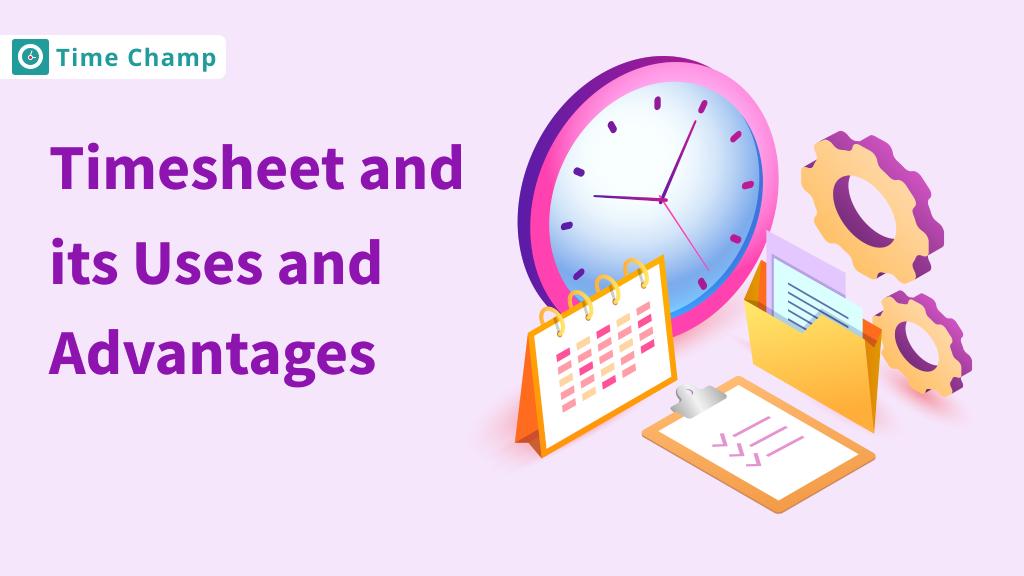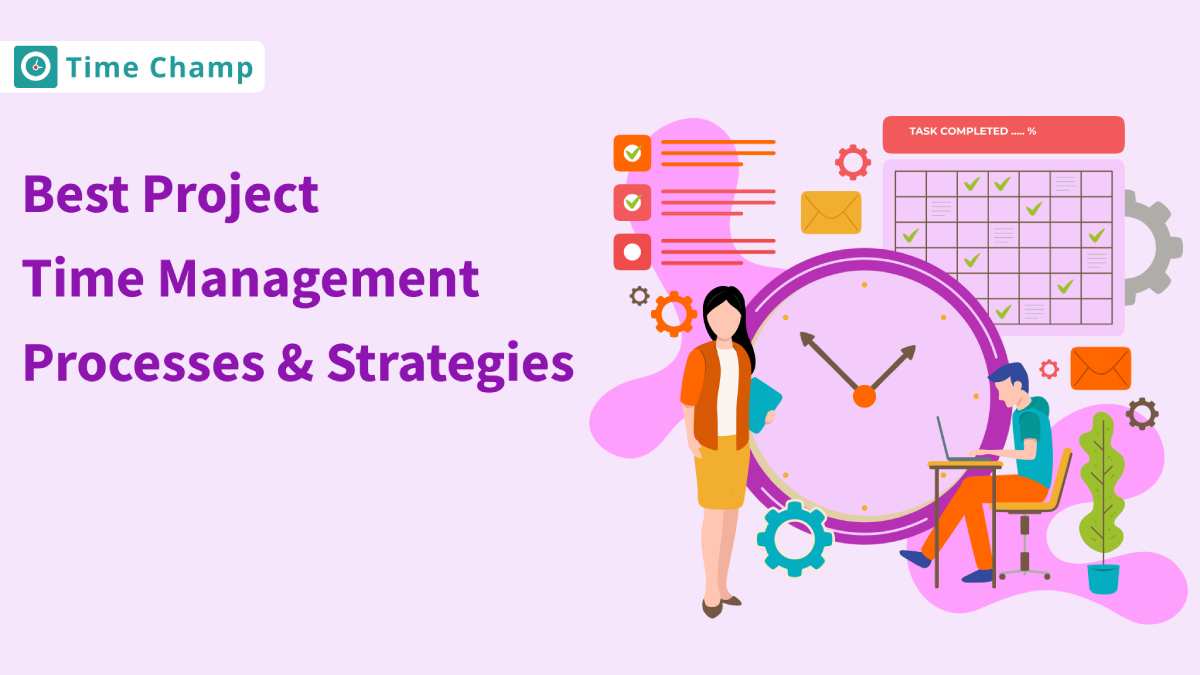Ever feel like there’s too much to do
and not enough time? A good time
management plan can fix that! Think
of it as organizing a puzzle-when
every task fits, life feels
smoother. In just 7 simple steps,
you’ll learn how to plan and manage
your time, stay focused, and get
more done with less stress.
Let’s get started!
What is a Time Management Plan?
A time management plan is a strategy that helps you organize and use your time effectively. It involves setting clear goals, deciding how much time to spend on each task, and planning your activities in a way that helps you get things done on time. The purpose of a time management plan is to stop wasting time and make sure you finish your work or activities in a smart and quick way.
Why is a Time Management Plan Important?
Imagine you are working on a task,
and all of a sudden you remember
something more important that you
should be doing instead. Now,
you’re stuck-time is running
out, you don’t know what to do next,
and everything feels like it’s
really important! That’s when
you really start to understand the
power of a time management schedule.
An effective time management
plan helps you stay on track and
organized. When you know what you
need to do and when to do it, you
don’t waste time and can focus on
getting things done.
With good
planning and time management, you
can get more done in less time. This
means you finish your work faster
and still have time for other things
you enjoy. It helps you balance
work, study, and personal life, so
you can reach your goals without
feeling overwhelmed.
6 Easy Steps to Develop Your Time Management Plan
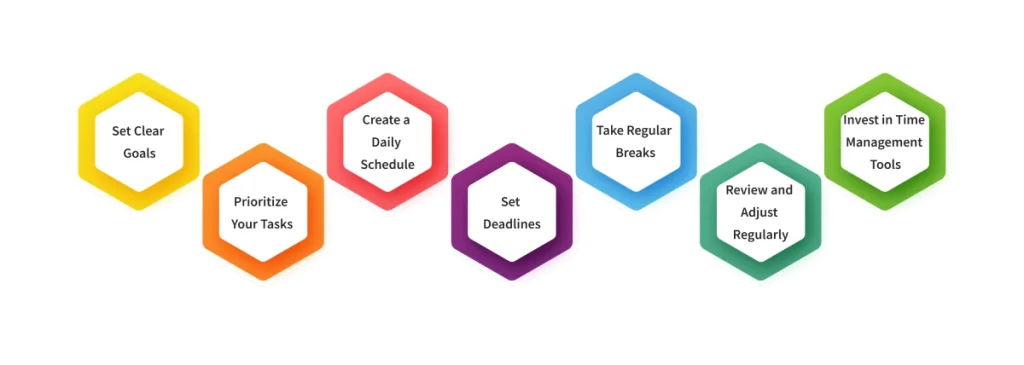
Set Clear Goals
Before you can achieve something, you need to set clear goal , don’t you? Start by defining your goals. When you’re clear about what you want to achieve, you can plan easily and accordingly. Break down the larger goals into smaller and simpler tasks. Ensure your goals are SMART- Specific, Measurable, Achievable, Relevant, and Time-bound. Writing down your goals helps you understand them better and motivates you to reach them.
Prioritize Your Tasks
Not every task deserves your time a lot. So, it is important to prioritize your tasks based on its importance. Make sure to focus on tasks that align with your goals that create the most impact. Avoid getting trapped in low-priority activities. If you’re unsure about how to prioritize your tasks, use the Eisenhower Matrix method which helps you to divide tasks into 4 categories, such as:
- Urgent and Important
- Not Urgent but Important
- Urgent but Not Important
- Not Urgent and Not Important.
Remember, effective prioritization is a cornerstone of successful time planning and management.
Create a Daily Schedule
To manage your time better, plan your day by organizing your tasks. Set specific times for each task and create a clear schedule. There are many tools out there such as calendars, weekly planner apps, digital to-do lists, etc. which help in scheduling your tasks. This helps you maintain a better balance between work and personal time. A good plan also keeps you focused and stops you from wasting time. Before you create a good schedule, read the below tips for effective time management and successful scheduling:
- Plan your significant activities during your most productive time of the day to keep yourself focused and achieve more.
- Don’t make your schedule too tight because this will lead to either skipping the activities or cramming.
- Additionally, maintain a consistent routine which helps to establish productive habits.
Set Deadlines & Take Regular Breaks
Deadlines are a powerful tool that
helps you stay on track and keep
focused. They create a sense of
urgency, making sure you don’t pull
things off. Don’t just set shorter
deadlines for important tasks just
because you want to finish them
soon. This won’t give you valuable
results as you expected. Make sure
to keep realistic deadlines which
gives you enough time to complete
tasks properly. Think of deadlines
as helpful guides, not something to
stress over. They can motivate you
to stay productive and push through
obstacles.
Working continuously
can lead to burnout and derail your
best plans. Take short breaks in
between the tasks to recharge and
stay focused. Don’t try to sit in
one place during your breaks. Take a
walk, eat something, lie down for a
while, stretch, step away from the
screen, etc. These activities
refresh your mind and help you stay
active.
Review and Adjust Regularly
Time management is an ongoing process that needs constant attention and flexibility. Review how things went, at the end of each day or week. Take a moment to look at what worked well and where you faced challenges. This review allows you to adjust your strategies and schedules, whether it’s making room for unexpected changes or finding ways to be more efficient. Reviewing your progress regularly keeps you on track, helps you learn from experiences and mistakes, and guarantees that you are always working towards achieving your goals.
Invest in Time Management Tools
To make your time planning easier and
smoother, there are several time
management tools out there. They
help organize your day, making sure
that your attention is paid to the
most important things. One such
powerful tool in the market is
“ Time Champ ”.
Time
Champ is a simple and powerful tool
that helps you manage your time
better. It tracks how much time you
spend on different tasks, giving you
reports to help you see where your
time goes. With features to organize
tasks and projects, you can stay on
top of your work and make sure
nothing gets missed. Time Champ also
tracks which apps and websites you
use most, helping you avoid
distractions and stay
focused.
Another great feature
is the ability to schedule your
tasks and adjust your work plan
easily. Time Champ also sends
reminders if you’ve been idle for
too long, so you stay productive.
Doesn’t matter if you’re
working alone or with a team, Time
Champ helps you stay organized, and
focused, making your time management
much easier than before.
What are the Benefits of a Time Management Plan?
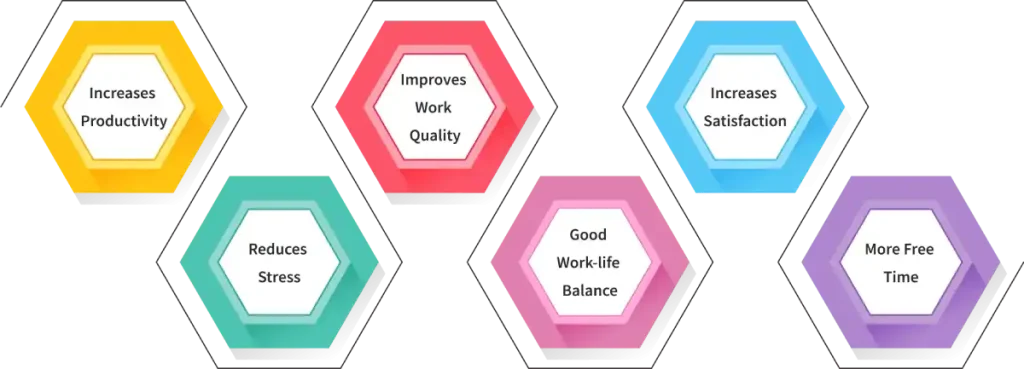
Increases Productivity
You won’t believe it but 90% of
individuals say that better time
management will improve their
productivity .Isn’t it good to hear?
An effective planning and time
management help you organize your
tasks and make the most of your
time. By clearly deciding what you
need to do and setting specific
deadlines, you stay focused and
avoid getting distracted. With a
clear plan, you won’t waste time
wondering what to do next –
you can jump right into your tasks
and get them done faster. This means
you become more productive and feel
less stressed, knowing exactly
what’s ahead for your day or week.
Reduces Stress
When you have a good time management plan in your hands, you are less likely to feel stressed. 90% of people say that better time management will lead to less stress. It’s because you have a detailed plan of what to do next, and when to do it without rushing things. This helps you to have a relaxed day and be more productive as well.
Improves Work Quality
A time management plan allows you to allocate the time for specific tasks based on their priorities. By this, you won’t feel rushed and spend a good amount of time on respective tasks. When you spend enough time on tasks, you will be more focused. This eventually results in high-quality results. The work quality improves and it helps you to plan better for the future.
Good Work-life Balance
Who doesn’t love to maintain a good work-life balance? You can achieve this by having a time management schedule. An effective time management plan helps you create a healthy work-life balance . By planning your day or week ahead of time, you can set aside specific moments for both work and personal activities, like spending time with family, hanging out with friends, or enjoying your favorite hobbies. This balance prevents you from being overstressed with work, while still giving you the space to chill.
Increases Satisfaction
Isn’t it satisfying when you finish your tasks before the deadline that you planned? When you properly schedule your time and complete assignments in a short time as required, you do the work well and feel good about it. This results in increased satisfaction and a feeling of achievement at the end of each day, thereby giving you a happier life in general.
More Free Time
When you use your time wisely, you can get through tasks quickly and easily, freeing up extra time for yourself. You can use this time to relax, enjoy your hobbies, or do things that make you happy. It also gives you a great chance to grow personally-whether it’s learning something new, getting healthier, or spending quality time with loved ones.
Simple and Effective Time Management Tips
Time Management Techniques
Time Blocking
Time blocking is one of the effective
time management techniques . It means
dividing your day into blocks of
time, where each block is devoted to
a specific task or set of tasks.
For instance, you can set 9
A.M. – 10 A.M. for handling
emails, from 11 A.M. – 12 P.M.
for presentations, and so on.
This method keeps you on track
by providing a specific goal for
each part of your day, thus
minimizing distractions and delays.
When you plan your day using this
technique, you become more
organized, productive, and
effective. It’s especially helpful
for managing both important work and
daily tasks.
Task Batching
Task Batching is a simple but
effective way to manage your time.
It helps you get more done by
grouping similar tasks together and
doing them all at once. Instead of
switching between different tasks,
you focus on one type of task at a
time, making it easier to work
faster and stay focused.
For
example, instead of checking and
replying to emails all day long, you
can set aside a specific time like
10:00 AM to 10:30 AM to handle them
all at once. Similarly, you can
dedicate 2:00 PM to 2:30 PM to make
phone calls or go through paperwork,
so you’re not jumping between
different tasks. This way, you save
time and energy while getting more
done!
Pomodoro Technique
The Pomodoro technique is a famous
time management method widely used.
The Pomodoro Technique is a simple
way to manage time by working in
short, focused intervals. You set a
timer for 25 minutes and work on a
task without distractions, which is
called a “Pomodoro.”
After the timer goes off, you take a
5-minute break to rest and
recharge.
After completing four
Pomodoros, you take a longer break,
usually 15-30 minutes. This helps
you stay focused without getting
stressed by too much work.
Eisenhower Matrix
If you’re stuck at categorizing and prioritizing tasks, this method has got you covered! The Eisenhower matrix is a proper time management method that helps you prioritize tasks based on their importance and urgency. It is basically divided into 4 categories:
- Urgent and Important
- Not Urgent but Important
- Urgent but Not Important
- Not Urgent and Not Important
This technique helps you focus on what actually matters, and avoid spending time on low-priority tasks.
Productivity Hacks
The 2-Minute Rule
The 2-Minute Rule is an effective time management practice that requires you to do any task that can be done in two minutes or less straight away. This helps to avoid the accumulation of small tasks and makes you concentrate on major goals.
The 80/20 Rule
The 80/20 Rule, also known as the
Pareto Principle, states that
roughly 80% of results come from 20%
of efforts. In simple terms, a small
portion of your actions often leads
to the majority of your
outcomes.
For example, in work,
20% of your tasks may produce 80% of
your results, meaning you should
focus on the most important tasks
that drive the most value. This rule
helps prioritize effort on what
matters most, making you more
efficient and effective.
Practical Tips
Conduct a Time Audit
Start by keeping track of how you spend your time each day. Write down everything you do, from work tasks and meetings to breaks and personal time. After a week, look over what you’ve recorded to spot any time-wasting habits or areas where you can do better. This will give you a clear picture of how you’re using your time, helping you make changes so you can focus on what really matters.
Spend Your Mornings on MITs
Mornings are when you’re usually the most focused and full of energy. Use this time to focus on your MITs-tasks that will make the biggest difference in reaching your goals. By handling your most important tasks first, you make sure they’re done and build energy that keeps you going for the rest of the day.
Learn to Say “No”
It’s easy to take on too many tasks, but saying “yes” to everything can waste your time and energy. Learn to say “no” to things that don’t help you reach your goals or match your priorities. This will help you save time and focus on what’s really important.
Avoid Multitasking
People may think multitasking helps
them finish tasks more easily, but
what about the results? What happens
to the unfinished tasks that get put
on hold while
multitasking?
Multitasking
might feel like a good idea, but it
actually makes you less productive
because it splits your focus. Focus
on one task at a time to do better
work and finish tasks more quickly.
When you give all your attention to
one task, you’re more likely to
finish it faster and achieve
good-quality results.
Methods and Frameworks
Employ the Rapid Planning Method (RPM)
The Rapid Planning Method (RPM) helps
you achieve your goals by first
figuring out what you want, and why
it’s important, and then creating a
plan to make it happen. It keeps you
motivated and focused, making it
easier to take quick and clear
actions toward your goals.
For
example, if your goal is to get fit,
start by saying, “I want to
lose 10 pounds.” Then, think
about why it matters: “I want
to feel healthier and have more
energy.” Finally, make a plan:
“I’ll exercise 30 minutes each
day and eat better.” This
method helps you stay on track with
simple, clear steps.
Getting Things Done (GTD)
Getting Things Done (GTD) is a simple system to help you manage your tasks and feel less stressed. First, write down everything you need to do or collect it in one place you trust. This could be tasks, ideas, or anything important. You can use a notebook, an app, or a planner to store it. By doing this, you don’t have to remember everything in your head, which can feel heavy and stressful. Writing it all down gives you a clear place to organize your tasks and focus on what’s most important.
Adopt the Swiss Cheese Method
The Swiss Cheese Method is a time management technique where you break big tasks into smaller, bite-sized pieces and work on them for short periods of time. Just like Swiss cheese has holes, the idea is to make progress on your task in “small chunks” whenever you have a little free time, instead of trying to finish the entire task all at once. It helps you move forward, even with just a little bit of time.
Consequences of Poor Time Management
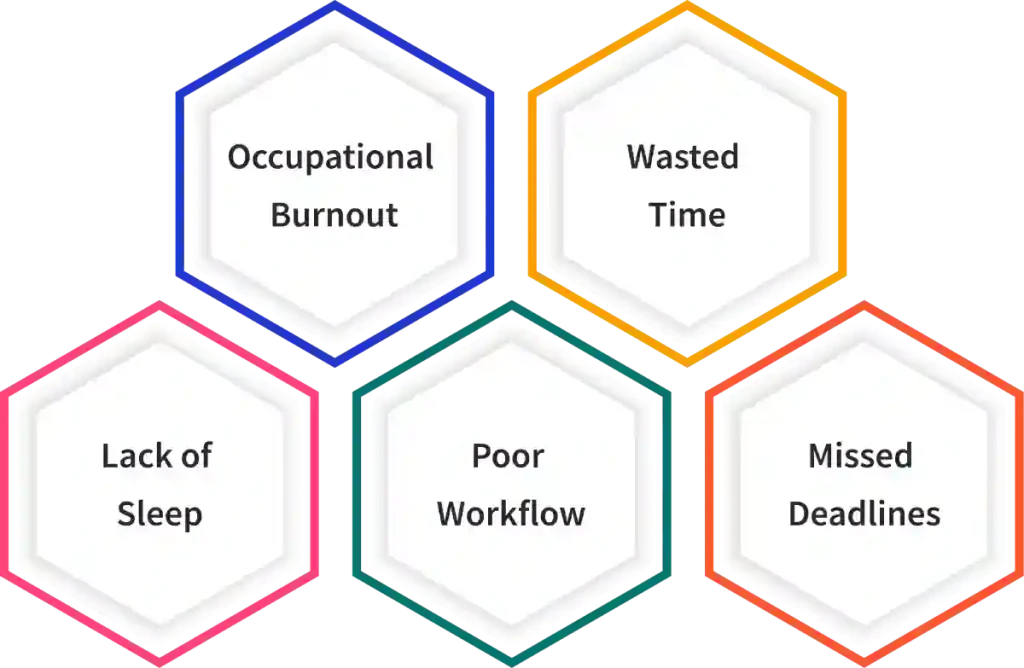
Occupational Burnout
Poor time management leads to taking
on too much work, which can make you
feel very tired and stressed. This
can cause burnout, lower your
productivity, and make you lose
interest in what you’re doing.
Managing tasks well and taking care
of yourself can stop this from
happening.
Wasted
Time
When you don’t manage your
time well, you often get distracted
and waste time. For example,
scrolling through your phone while
studying can make it harder to
concentrate and slow down your
progress.
Lack of Sleep
When your plan isn’t properly scheduled, it can mess up your sleep schedule. You might find yourself staying up late to finish tasks or sleeping at odd hours, which throws off your focus, harms your health, and makes it harder to think clearly or make good decisions.
Poor Workflow
When you don’t plan ahead and manage
your time well, things can quickly
become a mess. Without any proper
plan, you might jump between
multiple tasks or redo things, which
eventually causes confusion, wastes
time, and slows your overall
workflow.
For example, imagine
working on a project and starting
the report before gathering all the
data. Midway through the process,
you realize you’re missing
important data, and have to go back.
Sometimes, it is so frustrating to
realize that if only you had taken a
few minutes to plan, everything
would run more smoothly.
Missed Deadlines
Poor time management can cause you to miss deadlines, which can hurt your reputation and make you feel stressed. When you delay tasks, your work may not be as good, and others might not trust you. The stress of catching up can also make it harder to focus and finish your work.
Final Thoughts
In conclusion, making a proper time management plan helps you stay organized and use your time better. Setting goals, doing important tasks, and using simple tools helps you finish more work, feel less worried, and enjoy both work and life. A good plan keeps you focused and stops distractions, so you can finish tasks quicker. Checking your plan often helps you stay on track and gives you more free time to enjoy.
Take control of your day with Time Champ! Start managing your time smarter and achieve your goals effortlessly. Try Time Champ now!
Signup for FreeBook DemoFrequently Asked Questions
Take a planner and set a timetable for the day’s activities. Avoid anything that may divert your attention such as social networks. Try the Pomodoro Technique: to do 25 minutes of work followed by a 5-minute break.
Firstly, arrange your tasks according to their urgency, and secondly, divide your big tasks into small subtasks. Don’t forget to take some time off to rest so that you can get back to work fully charged.
Organize your work schedule, set achievable goals with time frames, and also do not forget to rest. Use adequate time at work and home in order not to get exhausted.




